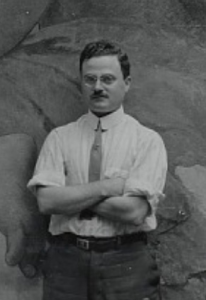
Biography
Vincent Aderente's career as a muralist predates that of most of the Depression Era muralists by three decades. He was born in Naples, Italy and came to America as a child. He studied at the Art Students League, but his development as a muralist came from working as an assistant to Edwin Blashfield, which he did from 1896-1926. Blashfield's work came to define the look of late 19th century government buildings in the United States, and Aderente carried on this tradition, whether working as an assistant, typically with Alonzo E. Foringer, or accepting his own commissions, occasionally also in collaboration with Foringer.
Many examples of Blashfield's work still exist, often restored when the original buildings were restored. Examples where Aderente assisted include the Luzerne County Courthouse (1909) in Wilkes Barre, PA, the Mahoning County Courthouse (1910) in Youngstown, OH, and the Hudson County Courthouse (1911) in Jersey City, NJ. The Mercer County Courthouse (1911) contains separate murals by Aderente and Foringer. Aderente painted the "Dream of Brigham Young" for the Utah State Capitol in 1916.
During World War I Blashfield executed the widely-distributed recruiting poster "Columbia Calls." Following the War, he assisted Blashfield on murals for the Detroit Public Library (1921-1922), and he assisted Blashfield for murals at MIT in 1923. He worked with Blashfield again in 1926 executing murals that Blashfield had designed for Saint Matthew the Apostle Cathedral in Washington, DC. The Codington (SD) County Courthouse (1929) features two Aderente murals, "Justice and Power" and "Wisdom and Mercy," and the Kings County Hospital (1932) has Aderente's mural "Enlightenment."
Aderente's one Post Office mural was painted in 1934 for the Flushing, NY Post Office. Entitled "Communities Served by the Flushing Post Office," this massive work has panels for Little Neck, Whitestone, Forest Hills, Douglaston, Bayside, Corona, Jackson Heights, College Point, Maspeth, Woodside, Elmhurst and Flushing as well as panels that illustrate mail delivery by locomotives, wagons, horsemen and ships.
Aderente was busy with several other commissions in the late thirties. He designed eight U.S. Government Bonds in 1935, much as his mentor Blashfield had designed the Two dollar bill back in 1895. He completed an expansive set of murals for the Denver Mint in 1939, and painted a mural for the Long Island Savings Bank in 1939 which sadly was stolen in 2000. He died prematurely in New York in 1941.


Critical Analysis
As an assistant to - and student of - Edwin Blashfield, Vincent Aderente was to some extent a holdover from the golden age of classical American murals. Blashfield's style, which carried over into many Aderent murals, was heavily allegorical. In the Depression Era, this approach was abandoned entirely - in favor of much simpler lines and a focus (obviously) on regional subject matter. Aderente's murals for the Flushing Post Office show how effortlessly he was able to make this transition. There are no allegorical figures in these murals, although perhaps a few totemic images. But overall the Flushing murals depict exactly what the Aderente's title promises: images of communities served by the Flushing Post Office. Each panel makes reference to some item of local significance, and the images are presented in a straightforward manner, consistent with the style that would be used in other Depression Era art.
Murals
- Flushing, New York - Post Office: Communities Served by the Flushing Post Office
References
- Edwin Howland Blashfield (Smithsonian American Art Museum).
- Vincent Aderente (askART).
- Vincent Aderente (Wikipedia).
- Vincent Aderente (1880-1941) (American Aristocracy).